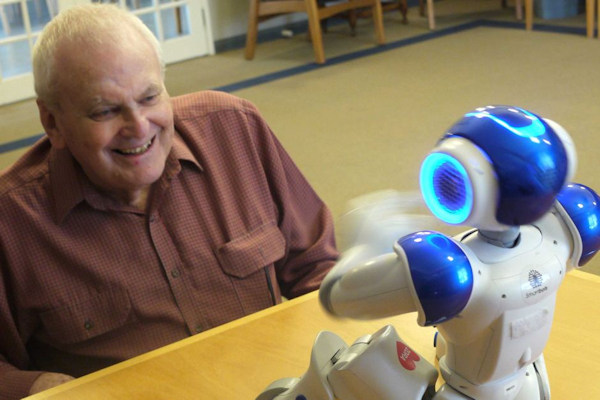[Aside from the very positive applications of presence it discusses, I like this story from Australia’s ABC because it brings together presence that results from mediated environments (VR) and social technologies (robots). The original story includes a 1:16 minute video and more pictures. –Matthew]

[Image: Colin Farmer plays rock, scissors, paper with Alice the robot. ABC News: Rebecca Turner]
Dementia patients using robots, virtual reality to engage
By Rebecca Turner
Sun April 2, 2017
High-tech tools, like humanoid robots and virtual reality are transforming the lives of people living in Australian dementia care facilities.
The technology — used to engage, entertain and encourage social interaction — is bringing the residents out of their shells.
In the process, it is dispelling any notion that age and cognitive impairment are a barrier to embracing technology.
At the Brightwater dementia facility in Madeley, in Perth’s northern suburbs, some residents have formed a close emotional bond with a small humanoid robot named Alice.
People with dementia often withdraw from social contact, but staff say they cannot keep residents away from Alice’s weekly music group.
With programming support from staff, Alice also runs exercise classes and a games hour where residents are encouraged to socialise.
Many clearly enjoy their interactions with the little robot.
For example, after being beaten by a jubilant Alice in a game of rock, paper, scissors, resident Colin Farmer patted her affectionately on the foot and said “thanks, mate”.
“She’s one of the family here now, a real member of the family,” Mr Farmer said.
Fellow resident, Joan Jones, said she was a little startled when Alice arrived at the facility in November 2015, but now considered her a friend.
“She communicates with us. And when we’re all there singing, she’s singing with us,” she said.
Alice was the first Zorabot introduced to a dementia facility in Australia, although the robots are used in facilities in Europe, Japan and the US.
She is a Nao robot which uses Zora software, developed in Europe and specially designed for aged care.
With the help of a National Health and Medical Research Council grant, Brightwater has begun a study to measure the effects of Alice on the engagement of residents and staff.
Chief executive Jennifer Lawrence said the final report would be published in August.
“We’re delighted about the level of engagement we have got from residents and we’re delighted about the reaction we have got from staff,” she said.
“Our staff were initially reticent — this technology is new, is it going to replace us?”
Encouraging interaction
In the southern Perth suburb of Bentley, the Kingia dementia facility run by Swancare has trialled the use of virtual reality goggles with great success.
For some residents, like Colin Price, imagining he was canoeing down a river surrounded by autumnal trees reminded him of when he lived in Japan.
“Absolutely fabulous. And it’s in Japan. That’s the change of the trees,” he said, as he watched the river scene.
For staff, it was an emotional moment watching Charlie Giuffre sit calmly and smile broadly as he used the goggles.
After taking them off, he became animated and initiated interaction with other residents.
They explained Mr Giuffre often did not communicate, found it hard to sit still, and would often abscond.
“It’s very rare that we seem him interact. It’s lovely to see,” activities officer Ashleigh Fitzgerald said.
The goggles were developed by Melbourne company Build VR specifically for use in aged care.
For dementia design specialist Debbie de Fiddes, who brought the goggles to the facility, the response from residents was vindication of her belief that technology can vastly improve the quality of life for people with dementia.
“So the more you can get people talking about their past and talking about their life, the more comfortable people are going to be living in this type of environment.
“Technology’s going to play a huge part going forward and there’s so many new things available.”
Ms de Fiddes has also introduced an interactive technology wall to the Kingia facility to provide a place for patients who like to wander to stop and be calm.
Patients can pretend they are dunking their hand in a fishpond or look at funny photos.
“We totally do all this to improve people’s quality of life,” she said.
“That’s what it’s about. It’s their last home.”